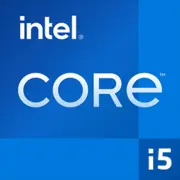Intel Core i5-11400T

Intel Core i5-11400T: Review and Recommendations for PC Builds in 2025
April 2025
Key Specifications
Architecture and Process Technology
The Intel Core i5-11400T belongs to the Rocket Lake generation (11th series), released in 2021. Despite utilizing a 14nm manufacturing process, which by 2025 is considered outdated, the processor remains relevant due to its optimized architecture. It features 6 cores and 12 threads, providing stable performance in multitasking scenarios. The base frequency is 1.5 GHz, with Turbo Boost up to 3.7 GHz.
Key Features
- Low Power Consumption: With a TDP of 35W, it is ideal for compact systems and workstations with limited cooling.
- Integrated Graphics: The UHD Graphics 730 supports 4K output and basic tasks like video playback or working with office applications.
- Cache Memory: 12MB of L3 cache accelerates the processing of frequently used data.
Performance
According to Geekbench 6 (2025):
- Single-Core: 1634 points — sufficient for everyday tasks.
- Multi-Core: 5747 points — suitable for rendering or streaming.
Practical Example: In an office PC with 16GB DDR4, the processor easily handles 20+ tabs in Chrome, Excel spreadsheets, and Zoom conferences without stutters.
Compatible Motherboards
Socket and Chipsets
The processor uses the LGA 1200 socket. Suitable chipsets include:
- H510: A budget option ($70-$90), without memory overclocking (maximum DDR4-2933). Example: ASUS Prime H510M-K.
- B560/H570: Supports DDR4-3200 and PCIe 4.0 (only for SSDs). Price: $100-$130 (MSI B560M Pro-VDH).
- Z590: For enthusiasts, with memory overclocking capabilities. Price: $150+ (Gigabyte Z590 UD AC).
Important: Z590 motherboards are overkill for the i5-11400T, but are relevant if upgrading to an i9-11900K is planned.
Supported Memory
The processor only supports DDR4 (up to 128GB, 3200 MHz). DDR5 and LPDDR4x are not supported.
Recommendations:
- For office tasks: 16GB (2x8GB) DDR4-2666.
- For video editing: 32GB DDR4-3200 (e.g., Crucial Ballistix).
Tip: Enable the XMP profile in BIOS to automatically overclock the memory to the specified frequency.
Power Supplies
With a TDP of 35W and no discrete graphics card, a PSU rated for 300-400W will suffice. However, for gaming builds with a GPU like the NVIDIA RTX 3050, choose models rated for 500-550W.
Examples:
- Budget: EVGA 500 BR ($45) — a reliable option for basic systems.
- Premium: Corsair CX550M ($70) — features modular cables and an 80+ Bronze certification.
Common Mistake: Using cheap noname power supplies may lead to voltage drops and component failures.
Pros and Cons
Strengths:
1. Energy efficiency — suitable for mini-PCs and NAS.
2. Integrated graphics — eliminates the need for a separate graphics card.
3. Availability — priced at $150-$180 (new, 2025).
Weaknesses:
1. Outdated 14nm process — higher heat generation under load.
2. No support for DDR5 and PCIe 5.0 — limits upgrade potential.
3. Turbo Boost operates inconsistently on budget motherboards.
Use Cases
1. Office and Education: Managing documents, browsing, video calls.
2. Media Center: Streaming 4K over HDMI 2.0, HEVC decoding.
3. Light Gaming: CS:GO — 60 FPS on medium settings (1080p), Dota 2 — 45-50 FPS.
4. Home Server: Energy-efficient hosting for websites or file storage.
Real-world example: A user assembled an HTPC with the i5-11400T, connected it to the TV, and uses it for Netflix and game streaming via Moonlight.
Comparison with Competitors
1. AMD Ryzen 5 5600G (6/12, 7nm, Vega 7):
- Pros: More powerful graphics, PCIe 4.0 support.
- Cons: Higher price ($160-$200).
- Geekbench 6: Single-Core 1702, Multi-Core 6105.
2. Intel Core i5-12400T (Alder Lake, 10nm):
- Pros: Energy efficiency, higher IPC.
- Cons: More expensive ($180-$220).
- Geekbench 6: Single-Core 1890, Multi-Core 7200.
Conclusion: The i5-11400T is more affordable but falls short in performance.
Practical Build Tips
1. Cooling: Even with a TDP of 35W, use a better cooler than the stock one (for example, DeepCool GAMMAXX 400 V2).
2. Storage: An NVMe SSD (e.g., Kingston NV2 500GB) will speed up system boot times.
3. Case: For passive cooling, a compact Mini-ITX (Fractal Design Node 304) is suitable.
Example Build for $500:
- Motherboard: ASUS Prime H510M-K ($80).
- Memory: 16GB DDR4-3200 ($50).
- SSD: 500GB NVMe ($45).
- PSU: EVGA 500 BR ($45).
- Case: Thermaltake Versa H15 ($40).
Final Conclusion: Who is the i5-11400T For?
This processor is a good choice for:
- Budget PCs: When cost-saving is essential without compromising basic performance.
- Office Workstations: Quiet and cool operation even over 8-10 hours.
- Home Media Centers: 4K content and streaming without lag.
Why you shouldn't buy it: If you plan to play AAA graphics games or work with 3D modeling, it’s better to invest in a Ryzen 5 7600 or Core i5-13400.
In 2025, the i5-11400T remains a niche solution, but it justifies the investment for its intended tasks.
Basic
CPU Specifications
Memory Specifications
GPU Specifications
Benchmarks
Compared to Other CPU
Share in social media
Or Link To Us
<a href="https://cputronic.com/cpu/intel-core-i5-11400t" target="_blank">Intel Core i5-11400T</a>